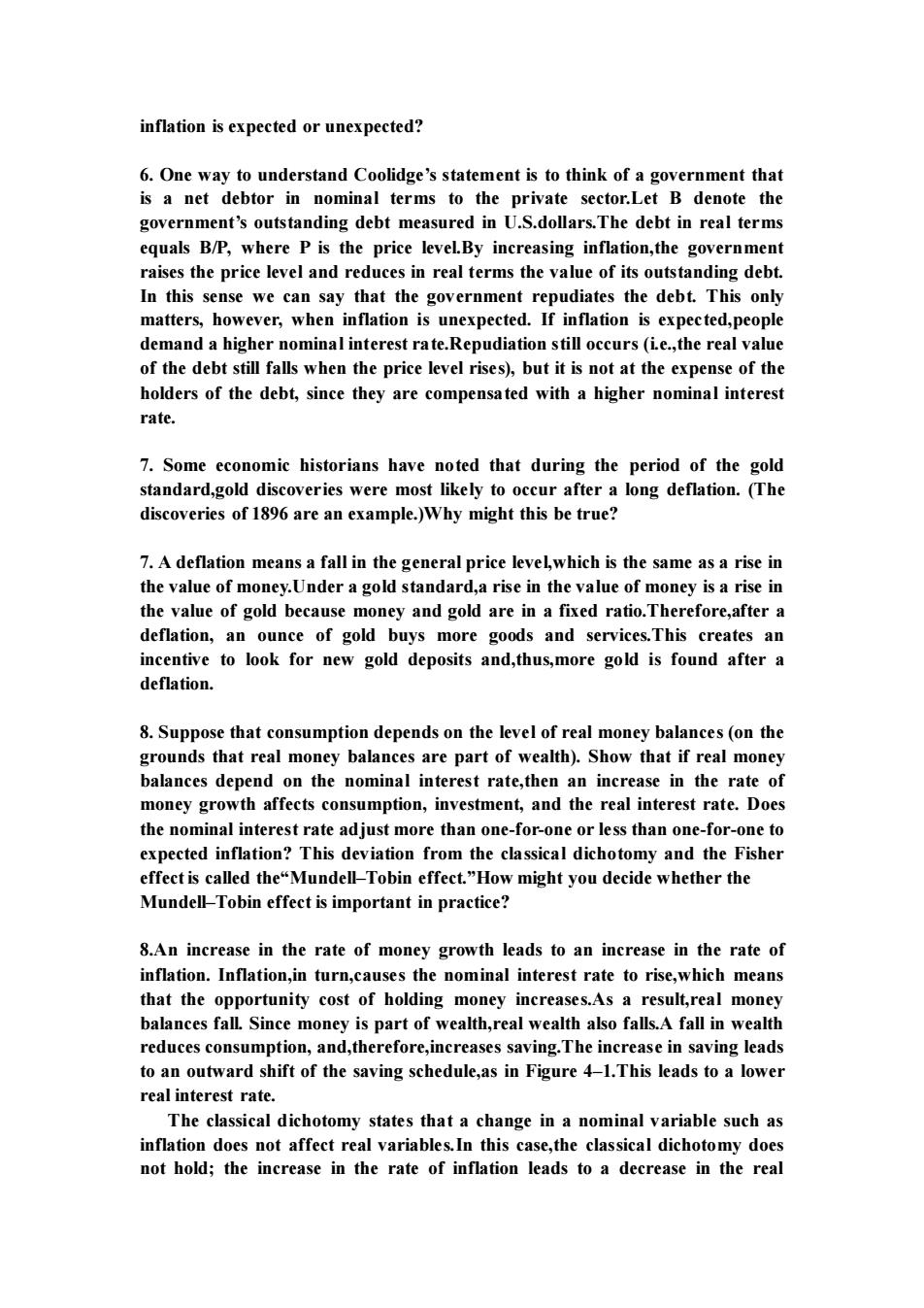正在加载图片...

inflation is expected or unexpected? 6.One way to understand Coolidge's statement is to think of a government that is a net debtor in nominal terms to the private sector.Let B denote the government's outstanding debt measured in U.S.dollars.The debt in real terms equals B/P,where P is the price level.By increasing inflation,the government ses the price level and reduces in real terms the valu e of its ou g debt. In this sense we can say that the government repudiates the debt.This only matters,however,when inflation is unexpected.If inflation is expected,people demand a higher nominal interest rate.Repudiation still occurs(i.e.,the real value of the debt still falls when the price level rises),but it is not at the expense of the holders of the debt,since they are compensated with a higher nor nal interest rate 7.Some economic historians have noted that during the period of the gold standard,gold discoveries were most likely to occur after a long deflation.(The discoveries of 1896 are an example.)Why might this be true? 7.A deflation means a fall in the general price levelwhich is the same as a rise in the value of money.Under a gold standard,a rise in the value of money is a rise in the value of gold because money and gold are in a fixed ratio.Therefore,after a deflation,an ounce of gold buys more goods and services.This creates an new gold deposits ,thus,more gold is found 8.Suppose that consumption depends on the level of real money balances(on the grounds that real money balances are part of wealth).Show that if real money balances depend on the minal int rest rate,then an inc ase in the rate of money growth affects umption,investment,and th real interes rate Does the nominal interest rate adjust more than one-for-one or less than one-for-one to expected inflation?This deviation from the classical dichotomy and the Fisher effect is called the"Mundell-Tobin effect."How might you decide whether the Mundell-Tobin effect is important in practice? 8.An increase in the rate of money growth leads to an increase in the rate of inflation.Inflation,in turn,causes the nominal interest rate to rise,which means that the opportunity cost of holding money increases.As a result,real money balances fall,Since money is part of wealth,real wealth ako falkA fall in ealth reduces nd.th g.The in eads to an outward s hift th e saving schedule,as in Figure 4 .This leads to a real interest rate The classical dichotomy states that a change in a nominal variable such as inflation does not affect real variables.In this case,the classical dichotomy does not hold;the increase in the rate of inflation leads to a decrease in the realinflation is expected or unexpected? 6. One way to understand Coolidge’s statement is to think of a government that is a net debtor in nominal terms to the private sector.Let B denote the government’s outstanding debt measured in U.S.dollars.The debt in real terms equals B/P, where P is the price level.By increasing inflation,the government raises the price level and reduces in real terms the value of its outstanding debt. In this sense we can say that the government repudiates the debt. This only matters, however, when inflation is unexpected. If inflation is expected,people demand a higher nominal interest rate.Repudiation still occurs (i.e.,the real value of the debt still falls when the price level rises), but it is not at the expense of the holders of the debt, since they are compensated with a higher nominal interest rate. 7. Some economic historians have noted that during the period of the gold standard,gold discoveries were most likely to occur after a long deflation. (The discoveries of 1896 are an example.)Why might this be true? 7. A deflation means a fall in the general price level,which is the same as a rise in the value of money.Under a gold standard,a rise in the value of money is a rise in the value of gold because money and gold are in a fixed ratio.Therefore,after a deflation, an ounce of gold buys more goods and services.This creates an incentive to look for new gold deposits and,thus,more gold is found after a deflation. 8. Suppose that consumption depends on the level of real money balances (on the grounds that real money balances are part of wealth). Show that if real money balances depend on the nominal interest rate,then an increase in the rate of money growth affects consumption, investment, and the real interest rate. Does the nominal interest rate adjust more than one-for-one or less than one-for-one to expected inflation? This deviation from the classical dichotomy and the Fisher effect is called the“Mundell–Tobin effect.”How might you decide whether the Mundell–Tobin effect is important in practice? 8.An increase in the rate of money growth leads to an increase in the rate of inflation. Inflation,in turn,causes the nominal interest rate to rise,which means that the opportunity cost of holding money increases.As a result,real money balances fall. Since money is part of wealth,real wealth also falls.A fall in wealth reduces consumption, and,therefore,increases saving.The increase in saving leads to an outward shift of the saving schedule,as in Figure 4–1.This leads to a lower real interest rate. The classical dichotomy states that a change in a nominal variable such as inflation does not affect real variables.In this case,the classical dichotomy does not hold; the increase in the rate of inflation leads to a decrease in the real